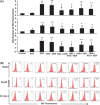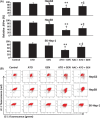Genistein synergizes with arsenic trioxide to suppress human hepatocellular carcinoma
- PMID: 20219070
- PMCID: PMC11159316
- DOI: 10.1111/j.1349-7006.2009.01464.x
Genistein synergizes with arsenic trioxide to suppress human hepatocellular carcinoma
Erratum in
- Cancer Sci. 2010 Jun;101(6):1574
Abstract
Arsenic trioxide (ATO) is of limited therapeutic benefit for the treatment of solid tumors. Genistein exhibits anticancer and pro-oxidant activities, making it a potential candidate to enhance the efficacy of ATO whose cytotoxicity is oxidation-sensitive. This study sought to determine whether genistein synergizes with ATO to combat hepatocellular carcinoma (HCC). Three human HCC cell lines, namely HepG2, Hep3B, and SK-Hep-1, were incubated with ATO, genistein, or ATO + genistein. The cells were also pretreated with antioxidant agents N-acetyl-L-cysteine (NAC) or butylated hydroxyanisole (BHA). Cell viability, apoptosis, intracellular reactive oxygen species (ROS), mitochondrial membrane potential (DeltaPsim), expression of Bcl-2, Bax, caspase-9, and -3, and release of cytochrome c into the cytosol were examined. The synergistic effect of ATO and genistein was also assessed using HepG2 xenografts subcutaneously established in BALB/c nude mice. The results show that genistein synergized with ATO to reduce viability, induce apoptosis, and diminish the DeltaPsim of cells. The combination therapy down-regulated Bcl-2 expression, up-regulated Bax expression, enhanced the activation of caspase-9 and -3, and increased the release of cytochrome c. The synergistic effect of ATO and genistein was diminished by pretreatment with NAC or BHA. Genistein increased the production of intracellular ROS, while ATO had little effect. Genistein synergized with a low dose of ATO (2.5 mg/kg) to significantly inhibit the growth of HepG2 tumors, and suppress cell proliferation and induce apoptosis in situ. There were no obvious side effects, as seen with a high dose of ATO (5 mg/kg). Combining genistein with ATO warrants investigation as a therapeutic strategy to combat HCC.
Figures








References
-
- Parkin DM, Bray F, Ferlay J et al. Global cancer statistics, 2002. CA Cancer J Clin 2005; 55: 74–108. - PubMed
-
- Roberts LR. Sorafenib in liver cancer – just the beginning. N Engl J Med 2008; 359: 420–2. - PubMed
-
- Newell P, Villanueva A, Llovet JM. Molecular targeted therapies in hepatocellular carcinoma: from pre‐clinical models to clinical trials. J Hepatol 2008; 49: 1–5. - PubMed
-
- Pang RW, Poon RT. From molecular biology to targeted therapies for hepatocellular carcinoma: the future is now. Oncology 2007; 72 (Suppl 1): 30–44. - PubMed
Publication types
MeSH terms
Substances
LinkOut - more resources
Full Text Sources
Medical
Research Materials

